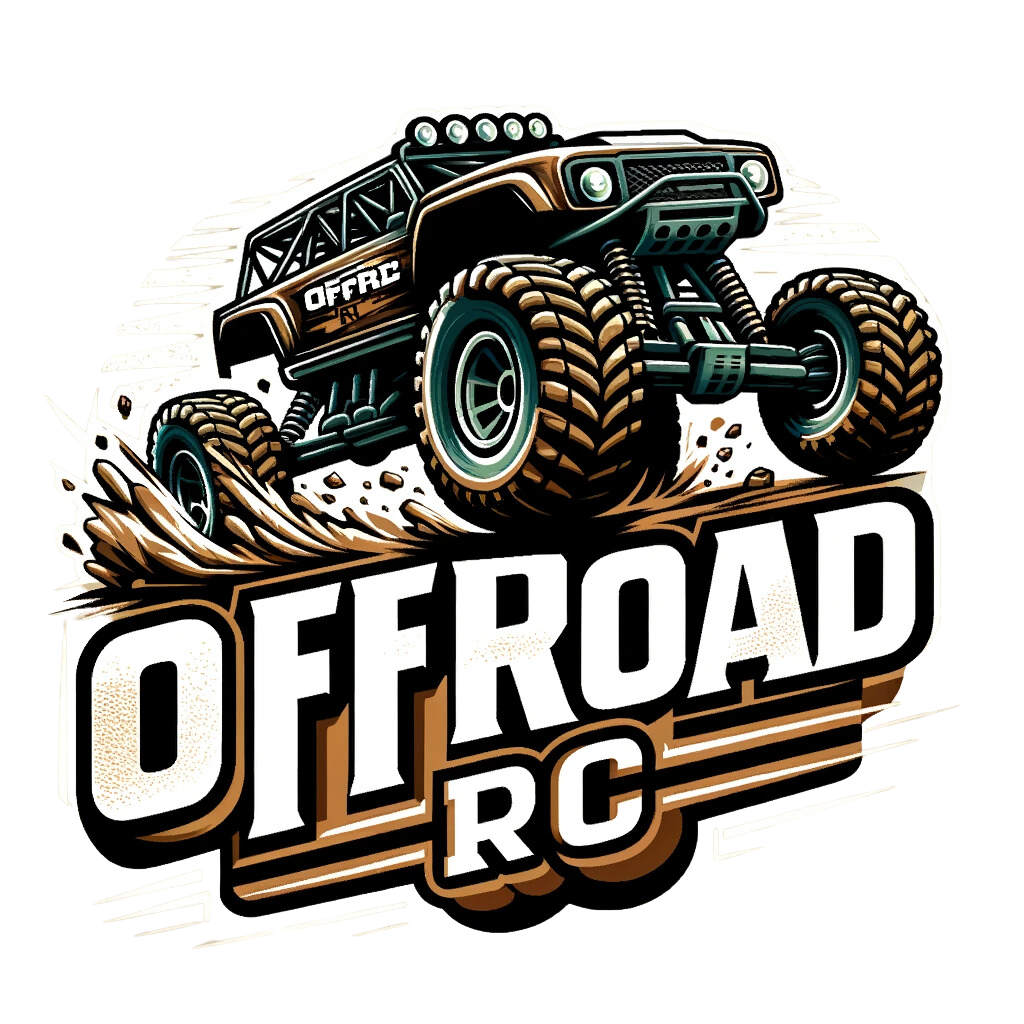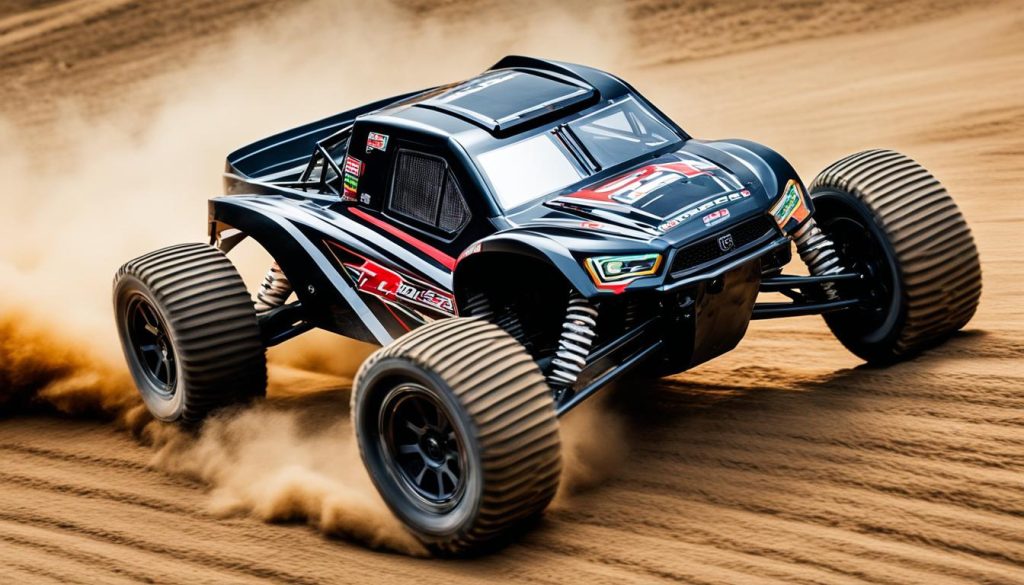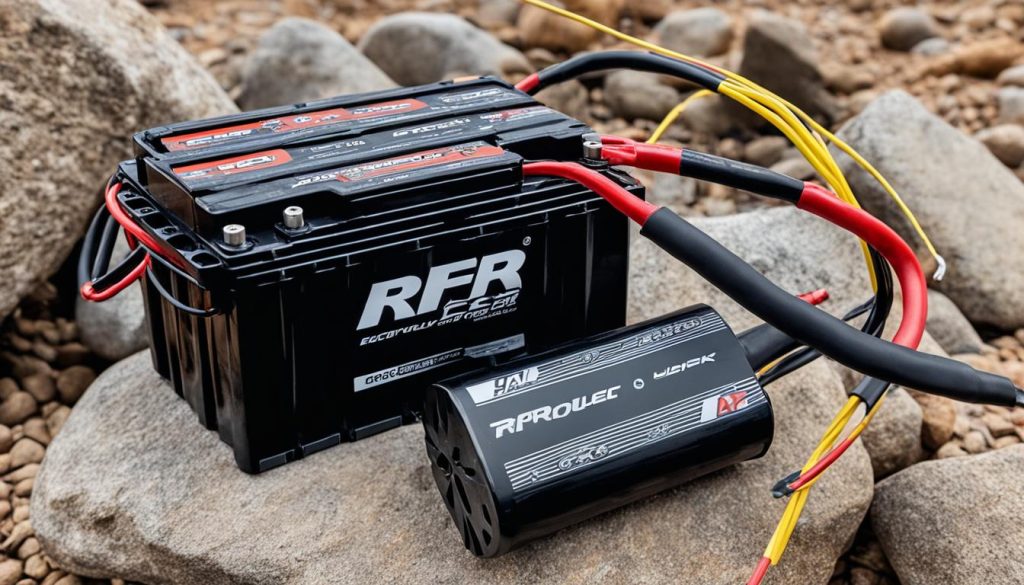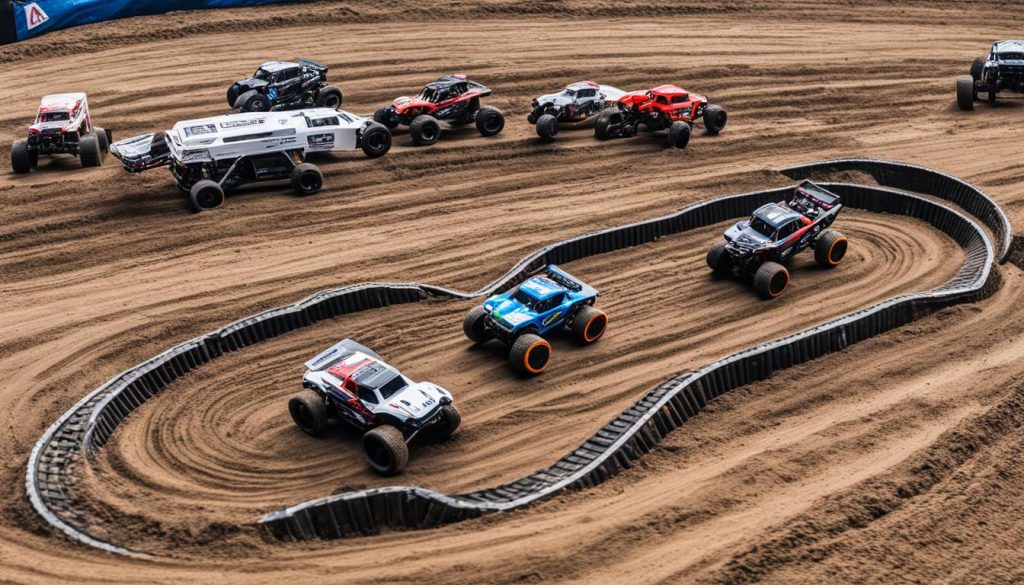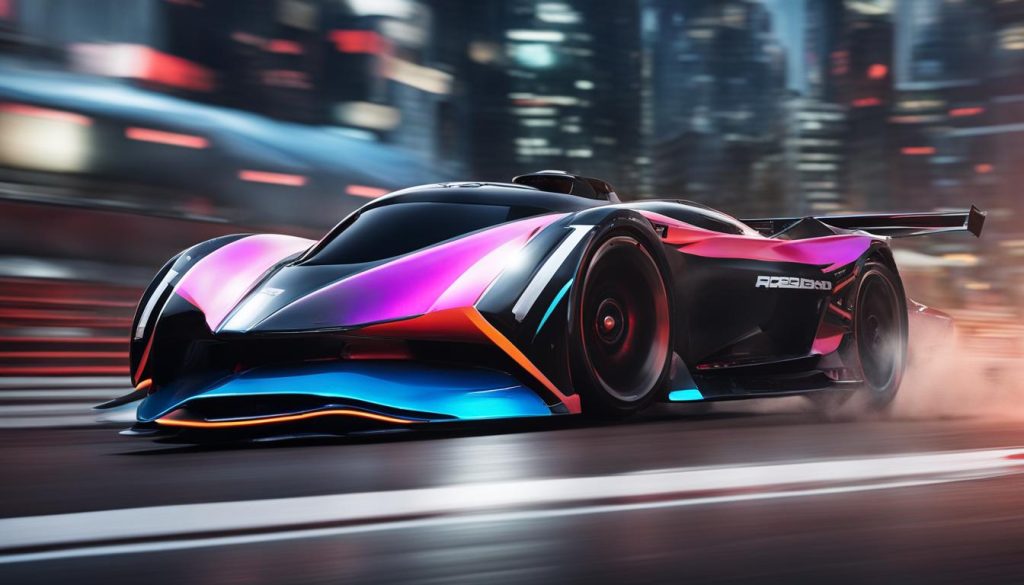Looking to improve the speed of your RC car? Upgrading the battery is one of the most effective ways to achieve faster speeds and better overall performance. By investing in a high-output battery with a greater voltage capacity, such as a nickel-metal hydride (NiMH) or lithium-polymer (Li-Po) pack, you can unlock the true potential of your RC car. These batteries have the ability to add an impressive 15-20 mph to your car’s top speed without the need for any other modifications.
Before upgrading your battery, it’s important to ensure that your motor can handle the extra power. Check your motor’s specifications to determine its compatibility with higher voltage batteries. Additionally, make sure to choose a battery that fits well in your car’s battery compartment.
Key Takeaways:
- Upgrading the battery can significantly improve the speed of your RC car.
- Invest in a high-output battery with a greater voltage capacity, such as NiMH or Li-Po.
- Ensure your motor is compatible with the increased power.
- Choose a battery that fits well in your car’s battery compartment.
- Enjoy a speed boost of 15-20 mph without any other modifications.
Upgrading to a Brushless Motor
When it comes to improving the speed and performance of your RC car, upgrading to a brushless motor is a game-changer. Brushless motors are specifically designed to run faster and more efficiently than standard brushed motors, offering remarkable gains in speed and acceleration.
Unlike brushed motors that rely on brushes and a commutator to transfer electrical power, brushless motors utilize electronic speed controllers (ESCs) to deliver power directly to the motor windings. This design eliminates the friction and resistance associated with brushed motors, resulting in smoother operation and increased efficiency.
One of the key advantages of brushless motors is their lower number of turns. This means that brushless motors can generate higher speeds compared to brushed motors. With a brushless motor, you can experience unparalleled performance and speed that will take your RC car to new heights.
If you’re still using a brushed motor in your RC car, it may be time for an upgrade. Consider investing in a high-performance brushless motor that is compatible with your RC car model. Look for a motor with the appropriate motor velocity constant (Kv) rating that matches your desired speed and torque requirements. A higher Kv rating indicates faster rotational speed, allowing for greater top speeds.
Upgrading to a brushless motor alone can make a significant difference in your RC car’s speed and performance. However, to fully harness the potential of a brushless motor, it’s essential to pair it with a high-performance battery.
| Upgrade Component | Effect on Speed |
|---|---|
| Brushless Motor | Significantly increases speed |
| High-Performance Battery | Improves power delivery to the motor for enhanced speed |
By combining the power of a brushless motor with a high-performance battery, you’ll unlock the full potential of your RC car, achieving breathtaking speed and performance on any track.
Upgrade your RC car with a brushless motor and experience a whole new level of speed like never before. Prepare to leave your competitors in the dust and dominate every race with the ultimate power and performance of a brushless motor.
Adjusting the Gear Ratio
The gear ratio of your RC car’s transmission plays a crucial role in determining its speed and performance. By making adjustments to the gear ratio, you can effectively improve your car’s speed and acceleration. In this section, we will explore how changing the sizes of the pinion gear and spur gear can provide a significant boost to your RC car’s speed.
When it comes to increasing speed, the key is to use a larger pinion gear with more teeth and a slightly smaller spur gear with fewer teeth. The pinion gear is the smaller gear connected to the motor shaft, while the spur gear is the larger gear connected to the drive shaft. By altering the sizes of these gears, you can manipulate the gear ratio and optimize it for faster performance.
Using a larger pinion gear with more teeth allows the motor to rotate the spur gear at a faster rate, resulting in increased speed. On the other hand, using a slightly smaller spur gear with fewer teeth reduces the resistance and friction within the gearbox, enabling smoother and faster rotation.
| Pinion Gear | Spur Gear | Resulting Gear Ratio |
|---|---|---|
| More teeth | Fewer teeth | Higher ratio (faster speed) |
It’s important to note that adjusting the gear ratio alone may require some trial and error to find the optimal settings for your RC car. Factors such as the terrain, motor power, and track conditions can influence the ideal gear ratio. Experimenting with different gear combinations and observing the performance of your RC car will help you fine-tune the gear ratio to achieve the desired speed and acceleration.
Pro Tip: If you’re unsure where to start, consult the manual or reach out to experienced RC car enthusiasts for recommendations on gear ratio adjustments for your specific model.
Now that you understand the importance of adjusting the gear ratio, let’s move on to the next section where we will explore how choosing the right tires can further improve the speed and performance of your RC car.
Choosing the Right Tires
The type of tires you use on your RC car can greatly affect its speed and performance. Different tread patterns and compounds are suited to different racing conditions.
If you’re racing on a smooth surface like a ceramic tile, use smooth tires for greater speed.
For off-road racing, choose tires with spikes or knobs for better traction.
Consider experimenting with different tire options to find the best combination for your desired speed and racing style.
Fast and Furious: Tire Comparisons
| Tire Type | Tread Pattern | Compound | Speed |
|---|---|---|---|
| Smooth Tires | Low profile, minimal patterns | Hard compound, less grip | High speed on smooth surfaces |
| Off-Road Tires | Aggressive spikes or knobs | Soft compound, high grip | Better traction on uneven terrain |
| All-Terrain Tires | Moderate tread, some knobs | Medium compound, balanced grip | Versatile performance on various surfaces |
Optimizing the Suspension
The suspension system of your RC car plays a crucial role in improving its speed and handling. By optimizing the suspension, you can enhance your car’s stability and enhance its ability to handle high speeds more effectively. Here are some key steps to follow:
1. Inspect and Maintain
Begin by checking your car’s shock absorbers and suspension components for any signs of damage or wear. Replace any worn-out parts to ensure optimal performance. Additionally, tighten any loose parts to eliminate any unnecessary play in the suspension system.
2. Adjust Suspension Settings
Next, adjust the suspension settings according to the type of track or terrain you’ll be racing on. Different track conditions require different suspension setups to maximize speed and handling. Experiment with different settings and find the ideal balance between stability and agility for your specific needs.
3. Test and Fine-Tune
Take your RC car for a test run after making suspension adjustments. Pay attention to how it responds to different surfaces and corners. Fine-tune the suspension settings as needed to ensure optimal performance and control.
Pro Tip: Keep a suspension tuning guide handy to help you understand how different adjustments affect your car’s performance. It’s a valuable resource for getting the most out of your suspension system.
4. Consider Upgrades
If you’re looking to take your RC car’s speed and handling to the next level, consider upgrading to a high-performance suspension system. Upgraded shocks, springs, and other suspension components can provide better control and improved overall performance, enabling you to push your car to its limits.
To further illustrate the importance of suspension optimization, take a look at the comparison table below:
| Standard Suspension | Optimized Suspension | |
|---|---|---|
| Speed | Good | Excellent |
| Handling | Fair | Superior |
| Stability | Fair | Excellent |
| Cornering Ability | Fair | Outstanding |
As you can see from the table, optimizing the suspension of your RC car can have a dramatic impact on its speed, handling, stability, and cornering ability. By following the steps outlined above, you’ll be well on your way to dramatically enhancing the performance of your RC car.
Fine-Tuning the Motor
When it comes to maximizing the speed and performance of your RC car, fine-tuning the motor timing is a crucial step. By adjusting the motor timing of your RC car’s brushless motor, you can increase its RPM (revolutions per minute) and overall speed.
Refer to the motor’s manual or guide to locate the motor timing dial. This dial allows you to make precise adjustments to the motor’s timing. By advancing or retarding the timing, you can optimize the motor’s performance to achieve faster speeds.
However, it’s important to be cautious when adjusting the motor timing. While increasing the timing can enhance your car’s horsepower and speed, it may also generate more heat in the motor. To prevent overheating, ensure that the motor is properly cooled during usage.
By fine-tuning the motor timing, you can unlock the full potential of your RC car’s brushless motor and improve its overall speed and performance.
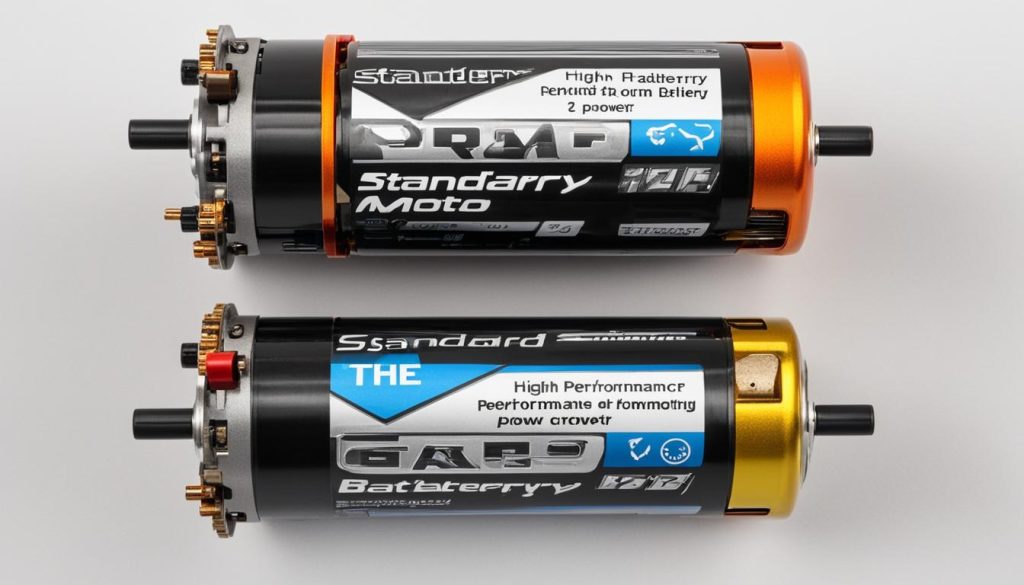
“Fine-tuning the motor timing is like finding the perfect balance between power and heat. With careful adjustments, you can unleash incredible speed and performance without compromising the motor’s durability.”
Motor Timing Adjustment Tips:
- Start with small adjustments: When fine-tuning the motor timing, it’s recommended to begin with small increments or decrements, typically in the range of 2-3 degrees.
- Test and observe: After each adjustment, take your RC car for a test run to observe the changes in speed and temperature. This will help you determine the optimal timing setting for your car.
- Monitor motor temperature: Keep an eye on the motor’s temperature during operation. If it starts to exceed safe levels, consider dialing back the timing to prevent overheating.
| Timing Adjustment | Effect on Speed | Effect on Motor Temperature |
|---|---|---|
| Advancing Timing | Increased RPM and speed | May generate more heat |
| Retarding Timing | Reduced RPM and speed | Lowers motor temperature |
Upgrading the Bearings
When it comes to improving the speed and performance of your RC car, upgrading the bearings is a crucial step. Most consumer-grade RC cars come with cheap brass bushings that can create friction and slow down performance. By replacing these bushings with high-quality ball bearings, you can significantly reduce friction and improve speed.
Ball bearings are designed to provide smooth rotation and reduce the strain on the engine, allowing your RC car to run faster and more efficiently. With less friction, your car can reach higher speeds and maintain them for longer periods, leading to improved overall performance.
Installing ball bearings is a relatively simple process and can be done without much technical expertise. Follow the manufacturer’s instructions or consult online tutorials for guidance. It’s important to choose ball bearings that are compatible with your RC car model and size.
Remember, proper lubrication is essential for maximizing the performance of your ball bearings. Use a high-quality bearing lubricant and ensure that the bearings are properly sealed to prevent dirt and debris from interfering with their smooth operation.
Upgrading your RC car’s bearings to high-quality ball bearings can provide a significant boost in speed and overall performance. Don’t let friction slow you down – give your car the advantage it deserves!
| Benefits of Upgrading RC Car Bearings | Expert Tip |
|---|---|
| Reduced friction | Always choose bearing lubricants specifically designed for RC cars to ensure optimal performance and longevity. |
| Improved speed and acceleration | Regularly clean and inspect your ball bearings to remove any dirt or debris that may affect their performance. |
| Enhanced overall performance | Consider investing in ceramic ball bearings for even higher performance gains. |
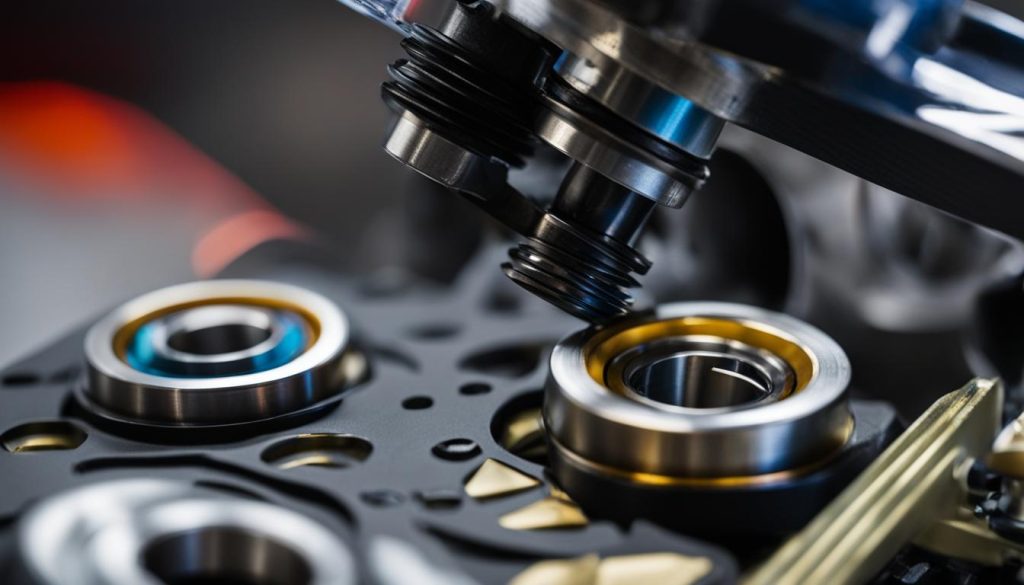
Making the Car Lightweight
Reducing the weight of your RC car is a key factor in improving its speed and agility. By replacing heavy parts with lighter materials and trimming unnecessary sections, you can optimize the car’s performance and achieve faster lap times. However, it’s important to strike a balance between weight reduction and maintaining proper traction for optimal speed.
Consider using lighter materials such as aluminum or graphite to replace bulky components. These materials offer durability without sacrificing performance. Additionally, removing any unnecessary sections of the chassis and body can further reduce weight and improve the car’s overall aerodynamics.
However, keep in mind that making the car too light can negatively impact its balance and stability. It’s crucial to find the right balance between weight reduction and maintaining the necessary stability to handle high speeds and sharp turns.
The Importance of Proper Weight Distribution
Proper weight distribution plays a crucial role in the car’s performance. It affects how the car corners, accelerates, and maintains stability at high speeds. By strategically placing the weight in the car, you can optimize its handling and improve overall performance.
A well-balanced car with proper weight distribution ensures maximum traction and stability during acceleration and cornering. It allows the tires to maintain optimal contact with the track surface, enhancing control and minimizing loss of traction.
“Proper weight distribution is the key to achieving faster lap times and better overall performance.”
Weight Reduction Techniques
Here are some effective ways to reduce the weight of your RC car:
| Technique | Description |
|---|---|
| Replace Heavy Components | Swap out heavy parts with lightweight alternatives like aluminum or graphite. |
| Trim Unnecessary Sections | Remove any unnecessary sections of the chassis and body to minimize weight. |
| Use Lightweight Wheels | Opt for lightweight wheels made from materials like carbon fiber or lightweight plastic. |
| Minimize Electronics | Choose lightweight electronic components that still meet your performance needs. |
| Consider Lighter Batteries | Invest in lightweight, high-performance batteries that provide adequate power. |
Remember, while weight reduction is important, it’s essential to maintain the structural integrity and durability of the car. Always consider the impact of each modification on the car’s performance and stability before making changes.
By effectively reducing the weight of your RC car, you can enhance its speed, agility, and overall performance on the race track.
Conclusion
By implementing the tips mentioned above, you can significantly increase the speed and performance of your RC car. Upgrading the battery, motor, gear ratio, tires, suspension, bearings, and reducing weight are all effective ways to boost speed.
When upgrading your RC car, remember to choose compatible components and fine-tune your car for optimal performance. Regular maintenance and practice will also contribute to improving your driving skills and achieving faster lap times.
Explore the various upgrades available and enjoy the thrilling world of RC car racing. With proper battery optimization and performance upgrades, you can take your RC car to new levels of speed and excitement.
FAQ
How can upgrading the battery of my RC car improve its speed?
Upgrading the battery of your RC car can significantly increase its speed and performance. Consider investing in a high-output battery with a greater voltage capacity, such as a nickel-metal hydride (NiMH) or lithium-polymer (Li-Po) pack. These batteries can add 15-20 mph to your car’s top speed without any other modifications. Make sure your motor can handle the extra power, and choose a battery of the appropriate size for your car’s battery compartment.
What are the benefits of upgrading to a brushless motor for my RC car?
Brushless motors are designed to run faster and more efficiently than standard brushed motors. They have a lower number of turns, allowing them to generate higher speeds. Consider replacing the brushed motor in your RC car with a high-performance brushless motor. Make sure to choose a motor with the appropriate motor velocity constant (Kv) rating for your desired speed. When upgrading to a brushless motor, it’s also a good idea to upgrade to a high-performance battery to fully maximize its potential.
How can adjusting the gear ratio of my RC car increase its speed?
The gear ratio of your RC car’s transmission can have a significant impact on its speed. By changing the sizes of the pinion gear (small gear) and spur gear (large gear), you can adjust the gear ratio and increase your car’s speed. To achieve higher speeds, use a larger pinion gear with more teeth and a slightly smaller spur gear with fewer teeth. This change in gear ratio will provide more power and speed to your RC car.
How do different tires affect the speed and performance of my RC car?
The type of tires you use on your RC car can greatly affect its speed and performance. Different tread patterns and compounds are suited to different racing conditions. If you’re racing on a smooth surface like a ceramic tile, use smooth tires for greater speed. For off-road racing, choose tires with spikes or knobs for better traction. Consider experimenting with different tire options to find the best combination for your desired speed and racing style.
How does optimizing the suspension of my RC car improve its speed?
The suspension system of your RC car plays a crucial role in its speed and handling. Check your car’s shock absorbers and suspension components for any damage or wear. Tighten any loose parts and ensure that the suspension is properly maintained. Adjust the suspension settings according to the type of track or terrain you’re racing on. A well-tuned suspension will improve your car’s stability and allow it to handle high speeds more effectively.
How can fine-tuning the motor timing increase the speed of my RC car?
The motor timing of your RC car’s brushless motor can be adjusted to increase its RPM (revolutions per minute) and overall speed. Refer to the motor’s manual or guide to locate the motor timing dial. Adjusting the motor timing requires careful precision and can greatly enhance your car’s horsepower. However, be mindful of the motor’s temperature as increased speed may generate more heat. Make sure the motor is properly cooled during usage to prevent overheating.
What are the benefits of upgrading the bearings in my RC car?
Upgrading your RC car’s bearings to high-quality ball bearings can reduce friction and improve speed. Most consumer-grade RC cars come with cheap brass bushings that can slow down performance. Replace these bushings with ball bearings to reduce engine strain and increase battery life. Installing ball bearings is relatively easy and can provide a significant boost in speed and overall performance.
How does making my RC car lightweight improve its speed?
Reducing the weight of your RC car can greatly improve its speed and agility. Consider replacing heavy parts with lighter materials such as aluminum or graphite. Trim unnecessary sections of the chassis and body to reduce weight. However, be cautious not to make the car too light, as it may affect its balance and stability. Strive for a balance between weight reduction and maintaining proper traction for optimal speed.
How can I boost the speed and performance of my RC car?
By implementing the tips mentioned above, you can significantly increase the speed and performance of your RC car. Upgrading the battery, motor, gear ratio, tires, suspension, bearings, and reducing weight are all effective ways to boost speed. Remember to choose compatible components and fine-tune your car for optimal performance. Regular maintenance and practice will also contribute to improving your driving skills and achieving faster lap times. Explore the various upgrades available and enjoy the thrilling world of RC car racing.
